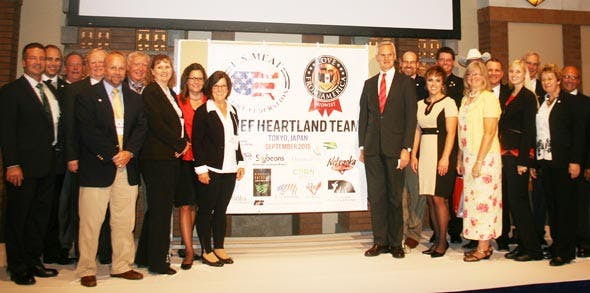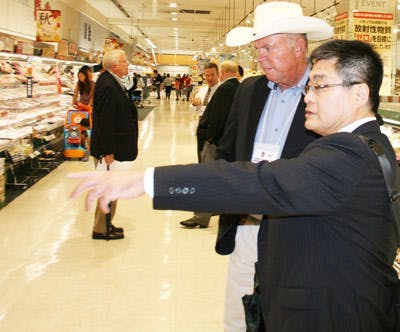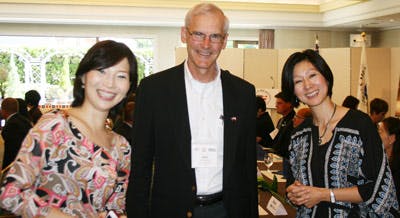‘Heartland Team’ Meets With Japanese Importers, Food Industry Professionals in Tokyo

The Heartland Team gathers for a group photo at a U.S. meat trade seminar in Tokyo
USMEF-Japan led a delegation of agricultural leaders from several Midwestern states this week to meet with importers, distributors, retailers and processors. The team also participated in a food blogger event and a U.S. meat trade seminar designed to promote U.S. beef and pork and build stronger business relationships with key members of the Japanese industry. Funding support for the blogger event and the meat trade seminar, which will be covered in more detail next week, was provided by the Beef Checkoff Program, the Pork Checkoff, the Nebraska Soybean Board, the Nebraska Beef Council, the Texas Beef Council and the USDA Market Access Program (MAP).

More than 700 Japanese importers and food industry representatives attended the U.S. meat trade seminar
The “Heartland Team” was made up of beef, pork, corn and soybean producers and industry representatives from Illinois, Nebraska, Minnesota and Missouri. Also included were Nebraska Lieutenant Governor Mike Foley, National Pork Board CEO Chris Hodges, Missouri Corn Merchandising Council CEO Gary Marshall and John Anderson, deputy chief economist with the American Farm Bureau.
At a Friday press conference concluding the trade mission, team members discussed their impressions of the market and the information they will be bringing back home to help the U.S. meat industry meet the demands of Japanese consumers and importers. A panel made up of Foley, Hodges, Marshall and Anderson explained to reporters that there is still plenty of room to expand U.S. exports to Japan, but the industry must remain aggressive in promoting and differentiating U.S. products and defending its market share.
“Japan is a mature market, but we still have plenty of opportunity here,” said Hodges, who noted that U.S. pork exports to Japan were sluggish in the first half of the year due in part to the West Coast port situation and lingering effects of PEDV. Hodges said he let it be known this week that “PEDV is behind us and U.S. pork production is up.”

Chris Abbott, a member of the Nebraska Beef Council board of directors, tours a retail outlet in Tokyo with USMEF-Japan Marketing Manager Satoshi Kato
When asked about the Trans-Pacific Partnership (TPP), Hodges is confident the agreement will help the U.S. compete with pork from the European Union, which continues to target the Japanese market and is currently in free trade agreement negotiations with Japan.
“First we have to get it signed,” Hodges said. “As we saw this week, the Japanese consumers are interested in quality. We think we have an advantage in that area.”
Anderson discussed the intense competition in Japan, as evidenced during the team’s visit to a cold storage facility in Tokyo.
“This is a market that has to be worked continuously – there are a lot of countries out there that want a piece of Japan,” said Anderson. “Still, the growth potential is tremendous.”
Anderson spoke about Japan’s beef imports and the U.S. effort to continue to gain traction in the market. As with pork, there is plenty of competition facing U.S. beef. Tariffs imposed on U.S. beef exports continue to be a sticking point.
“From an industry perspective, we are at a disadvantage to Australia, and we would like to see that taken care of,” he said. “We have a big presence in the Japan market, and we don’t want our position to be downgraded.”
Marshall and Foley both lauded USMEF and its work in Japan, noting the staff’s effort to connect Japanese consumers to U.S. beef and pork.

National Pork Board CEO Chris Hodges, center, meets with cooking instructor Rika Yukimasa (left) and USMEF-Japan’s Tazuko Hijikata at the blogger event
“During our visit we have seen evidence of how USMEF ‘tells the story’ of U.S. meat and we have seen how producers and exporters deliver quality to Japan,” said Marshall. “USMEF has really done a good job of putting a face on U.S. meat production.”
Foley said that during the trip he learned a lot about trade and how USMEF adds value to the meat produced back home in his state.
“We are building on a growing relationship with Japan, and that is good news for U.S. agriculture and Nebraska agriculture,” he said. “The Japanese like to meet face-to-face with the people who are providing their food, and that’s what we did during our visit. This kind of thing helps in the continued building of our relationship.”
Earlier in the week, the team participated in a briefing at the U.S. embassy in Tokyo, where it met with officials from Prima Meat Packers, which produces and sells hams, sausages, meats and other processed food products. It also visited the headquarters of the Marubeni Corporation, a diversified trading company involved in international transactions for a wide range of products.
Stops were made at retail food stores in Tokyo to observe U.S. pork promotions and to meet with buyers from the supermarket chains. The team toured the Tokyo Meat Market to observe a wagyu carcass auction, followed by a meeting with Starzen, one of Japan's largest meat wholesaling and processing companies. The team was also hosted by the Nippon Group for a tour of Nihon Butsuryu, Tokyo’s largest cold storage facility, where U.S. beef and pork were in transit to end users, along with competitors’ brands.
The team also met with U.S. packer representatives in Japan, including USMEF member companies Tyson Foods, National Beef, Cargill Meat Solutions, JBS and Smithfield Foods.
